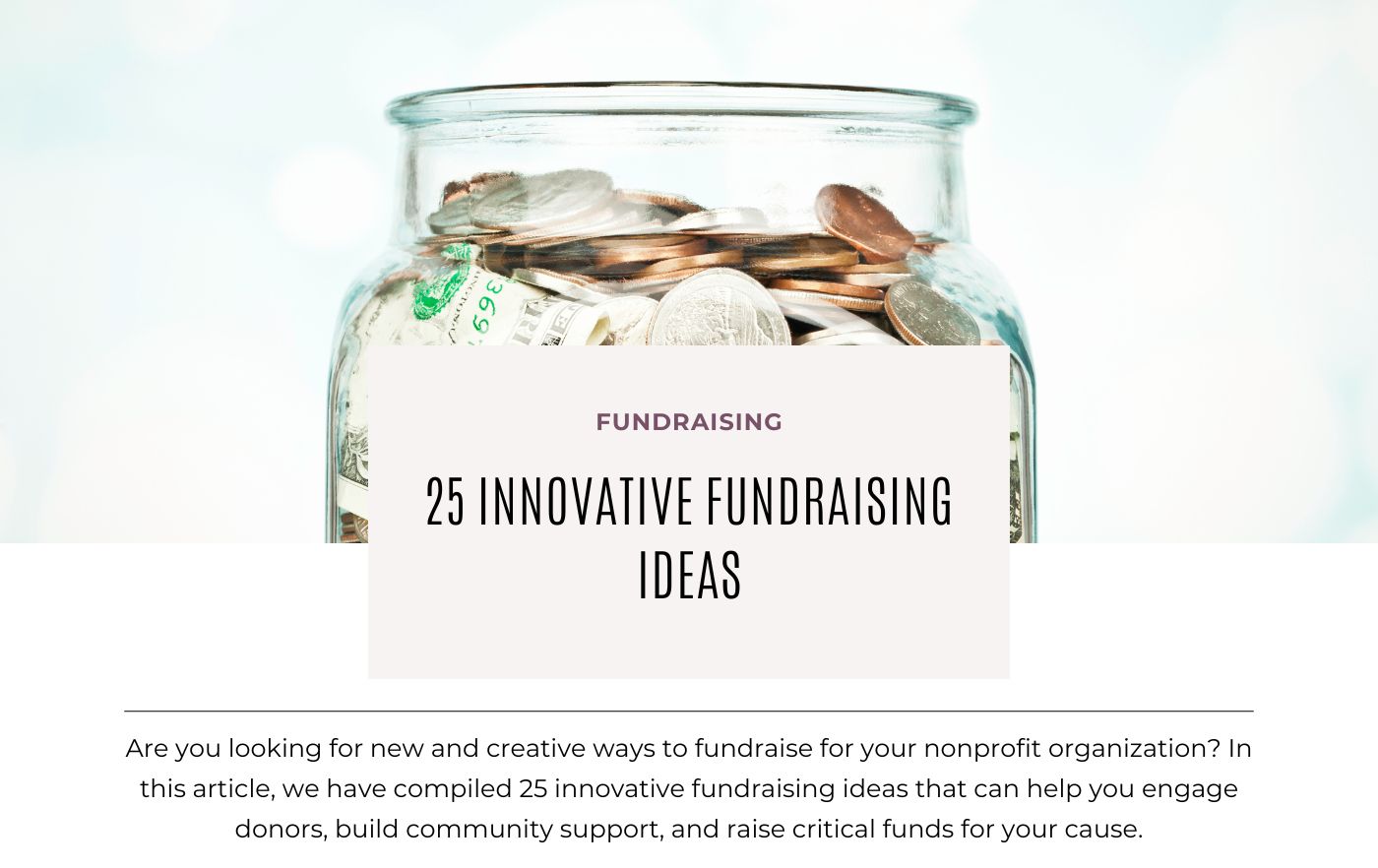Thinking Outside the Box: Unconventional Fundraising Strategies
When it comes to fundraising, many organizations and individuals rely on traditional methods, such as charity runs, bake sales, and auctions. However, with the rise of digital technologies and changing donor behaviors, it’s essential to think creatively and explore novel fundraising ideas to stay ahead of the curve. By embracing unconventional fundraising strategies, organizations can differentiate themselves, engage their audience, and ultimately raise more funds.
One of the primary benefits of novel fundraising ideas is their ability to capture attention and generate buzz. In today’s crowded fundraising landscape, it’s easy for traditional methods to get lost in the noise. By thinking outside the box, organizations can create unique and memorable experiences that resonate with donors and inspire them to give. For instance, hosting a charity escape room or a fundraising hackathon can provide an exciting and interactive way to engage supporters and raise funds.
Another advantage of unconventional fundraising strategies is their potential to reach new audiences. Traditional fundraising methods often rely on existing networks and donor bases. However, novel fundraising ideas can help organizations tap into new demographics, interests, and communities. For example, partnering with social media influencers or hosting a crowdfunding campaign can help organizations reach a wider audience and attract new supporters.
Furthermore, novel fundraising ideas can provide a unique opportunity for organizations to showcase their creativity and innovation. By embracing new and unconventional approaches, organizations can demonstrate their commitment to thinking outside the box and pushing the boundaries of what’s possible. This can help build trust and credibility with donors, who are increasingly looking for organizations that share their values and approach to philanthropy.
As organizations explore novel fundraising ideas, it’s essential to keep in mind the importance of measuring success and evaluating effectiveness. By tracking key metrics, such as return on investment (ROI) and donor retention rates, organizations can refine their approaches and ensure that their fundraising efforts are aligned with their overall mission and goals.
By embracing novel fundraising ideas and thinking creatively, organizations can unlock new opportunities for growth, engagement, and fundraising success. Whether it’s hosting a charity puzzle competition or launching a social media challenge, the possibilities are endless. So why not think outside the box and explore the world of novel fundraising ideas? Your donors – and your bottom line – will thank you.
From Crowdfunding to Corporate Partnerships: Exploring New Avenues
Novel fundraising ideas are not limited to traditional methods. In recent years, crowdfunding, corporate partnerships, and social media campaigns have emerged as effective ways to raise funds and engage supporters. These approaches offer a range of benefits, including increased visibility, improved donor engagement, and access to new funding streams.
Crowdfunding, for example, has become a popular way for organizations to raise funds for specific projects or initiatives. Platforms like Kickstarter, Indiegogo, and GoFundMe provide a space for organizations to share their story, set a funding goal, and encourage supporters to contribute. Successful crowdfunding campaigns often rely on creative marketing strategies, engaging storytelling, and a clear call to action.
Corporate partnerships are another innovative way to raise funds. By partnering with businesses, organizations can access new funding streams, leverage corporate resources, and tap into the company’s network of customers and employees. Effective corporate partnerships require a clear understanding of the company’s goals, values, and target audience, as well as a compelling proposal that outlines the benefits of the partnership.
Social media campaigns have also become a crucial component of novel fundraising ideas. Platforms like Facebook, Twitter, and Instagram provide a space for organizations to share their story, engage with supporters, and encourage donations. Successful social media campaigns often rely on creative content, strategic hashtag use, and a clear call to action.
For example, the ALS Association’s Ice Bucket Challenge is a notable example of a successful social media campaign. The challenge, which encouraged people to dump a bucket of ice water over their heads and nominate others to do the same, raised over $100 million for ALS research and became a viral sensation on social media.
Other novel fundraising ideas include hosting charity streaming events, creating social impact investing opportunities, and leveraging artificial intelligence to personalize donor engagement. By exploring these new avenues, organizations can stay ahead of the curve, engage their audience, and raise more funds for their cause.
When implementing novel fundraising ideas, it’s essential to keep in mind the importance of measuring success and evaluating effectiveness. By tracking key metrics, such as return on investment (ROI) and donor retention rates, organizations can refine their approaches and ensure that their fundraising efforts are aligned with their overall mission and goals.
How to Host a Unique Fundraising Event: Tips and Tricks
Hosting a unique fundraising event can be a great way to raise funds and engage your audience. However, it requires careful planning and execution to ensure success. Here are some tips and tricks to help you host a memorable and effective fundraising event.
First, choose a theme that aligns with your organization’s mission and values. This will help you to create a cohesive and engaging event that resonates with your audience. For example, if you’re hosting a charity event for a children’s hospital, you could choose a theme like “A Night Under the Stars” or “A Magical Wonderland.”
Next, select a venue that fits your theme and budget. Consider renting a unique space, such as a museum, art gallery, or historic landmark. This will help to create a memorable and Instagram-worthy experience for your guests.
Promoting your event is crucial to its success. Use social media to create buzz and excitement around your event. Create a Facebook event page, tweet about your event, and post eye-catching graphics on Instagram. You can also use email marketing to send out invitations and reminders to your guests.
Another key aspect of hosting a successful fundraising event is to offer unique and engaging experiences for your guests. This could include live music, auctions, raffles, or even a photo booth. Consider offering exclusive experiences, such as a meet-and-greet with a celebrity or a behind-the-scenes tour of a local landmark.
Finally, don’t forget to follow up with your guests after the event. Send out thank-you emails and surveys to gather feedback and build relationships with your supporters. This will help to create a loyal community of donors and advocates who will support your organization for years to come.
Some novel fundraising ideas for events include hosting a charity escape room, a fundraising hackathon, or even a social impact investing conference. These types of events can help to attract a new and diverse audience, while also providing a unique and engaging experience for your guests.
By following these tips and tricks, you can host a unique and successful fundraising event that raises funds and engages your audience. Remember to think outside the box and be creative when planning your event. With careful planning and execution, you can create a memorable and effective fundraising event that supports your organization’s mission and values.
Leveraging Technology to Boost Fundraising Efforts
Technology has revolutionized the way organizations approach fundraising. With the rise of online donation platforms, social media fundraising tools, and mobile apps, it’s easier than ever to reach a wider audience and streamline fundraising efforts. By leveraging technology, organizations can increase their fundraising potential, engage their audience, and build a stronger community of supporters.
Online donation platforms, such as Network for Good and Qgiv, provide a secure and easy way for donors to give online. These platforms often offer features such as recurring donations, donor tracking, and customizable donation pages. By using an online donation platform, organizations can increase their online giving and reduce administrative costs.
Social media fundraising tools, such as Facebook Fundraisers and Instagram Donations, allow organizations to raise funds directly on social media platforms. These tools provide a convenient way for supporters to donate and share fundraising campaigns with their networks. By using social media fundraising tools, organizations can increase their online visibility and reach a wider audience.
Mobile apps, such as Charity Miles and Walk for a Dog, provide a unique way for organizations to engage their audience and raise funds. These apps often offer features such as gamification, social sharing, and rewards for donors. By using mobile apps, organizations can increase their fundraising potential and build a stronger community of supporters.
Artificial intelligence (AI) is also being used in fundraising to personalize donor engagement and improve fundraising outcomes. AI-powered tools, such as donor segmentation and predictive analytics, can help organizations identify and target high-value donors, optimize their fundraising strategies, and improve their overall fundraising performance.
Virtual reality (VR) is another emerging trend in fundraising. VR experiences can be used to raise awareness and funds for social causes, provide immersive experiences for donors, and create a sense of empathy and connection with the cause. By using VR, organizations can increase their fundraising potential and build a stronger community of supporters.
By leveraging technology, organizations can stay ahead of the curve and maximize their fundraising potential. Whether it’s using online donation platforms, social media fundraising tools, mobile apps, AI, or VR, technology provides a range of innovative solutions for organizations to engage their audience, build a stronger community of supporters, and raise more funds for their cause.
Engaging Your Community: Building a Strong Fundraising Network
Building a strong fundraising network is crucial for any organization or individual looking to raise funds. A strong network can provide access to new donors, volunteers, and sponsors, and help to build a loyal community of supporters. In this article, we will discuss the importance of engaging with the local community and provide tips on how to cultivate relationships with donors, volunteers, and sponsors.
One of the most effective ways to engage with the local community is to host events and activities that bring people together. This can include charity runs, auctions, and fundraising galas. By hosting events, organizations can raise awareness and funds for their cause, while also building relationships with potential donors and supporters.
Another way to engage with the local community is to partner with local businesses and organizations. This can include corporate sponsorships, cause-related marketing, and community outreach programs. By partnering with local businesses and organizations, organizations can access new resources and networks, while also building relationships with potential donors and supporters.
Social media is also a powerful tool for engaging with the local community. By using social media platforms, organizations can raise awareness and funds for their cause, while also building relationships with potential donors and supporters. Social media can also be used to share stories and updates about the organization’s work, and to provide a platform for supporters to share their own stories and experiences.
Volunteers are also a crucial part of any fundraising network. By recruiting and engaging volunteers, organizations can access new skills and resources, while also building relationships with potential donors and supporters. Volunteers can also help to spread the word about the organization’s work, and to provide a personal touch to fundraising efforts.
Donor relationships are also critical to building a strong fundraising network. By cultivating relationships with donors, organizations can build trust and loyalty, while also accessing new resources and networks. Donor relationships can be built through regular communication, personalized appeals, and recognition of donor contributions.
Finally, sponsors are also an important part of any fundraising network. By partnering with sponsors, organizations can access new resources and networks, while also building relationships with potential donors and supporters. Sponsors can also help to provide a platform for fundraising efforts, and to provide a personal touch to fundraising appeals.
By engaging with the local community, building relationships with donors, volunteers, and sponsors, and using social media to raise awareness and funds, organizations can build a strong fundraising network that will help them to achieve their goals.
Measuring Success: Evaluating the Effectiveness of Your Fundraising Efforts
Evaluating the effectiveness of fundraising efforts is crucial to understanding what works and what doesn’t. By measuring success, organizations can refine their strategies, optimize resources, and ultimately raise more funds. In the context of novel fundraising ideas, it’s essential to track progress and adjust approaches accordingly. One way to do this is by using metrics such as return on investment (ROI) and donor retention rates.
ROI is a key metric that helps organizations determine the financial return of their fundraising efforts. By calculating the ratio of funds raised to the cost of fundraising, organizations can identify which strategies are generating the most revenue. For instance, if a crowdfunding campaign yields a high ROI, it may be worth repeating or scaling up. On the other hand, if a corporate partnership is not generating sufficient returns, it may be time to re-evaluate the relationship.
Donor retention rates are another critical metric that can help organizations evaluate the effectiveness of their fundraising efforts. By tracking the percentage of donors who continue to support the organization over time, organizations can identify areas for improvement. For example, if donor retention rates are low, it may indicate a need to improve communication, offer more personalized engagement, or provide better recognition and rewards.
In addition to ROI and donor retention rates, organizations can also use other metrics such as website analytics, social media engagement, and email open rates to evaluate the success of their fundraising efforts. By monitoring these metrics, organizations can gain a deeper understanding of their audience, identify trends and patterns, and make data-driven decisions to optimize their fundraising strategies.
When it comes to novel fundraising ideas, it’s essential to be flexible and adapt to changing circumstances. By regularly evaluating the effectiveness of fundraising efforts, organizations can pivot quickly and make adjustments as needed. This might involve trying new approaches, refining existing strategies, or scaling up successful initiatives.
Ultimately, measuring success is an ongoing process that requires continuous monitoring and evaluation. By using a range of metrics and staying attuned to the needs and preferences of their audience, organizations can refine their fundraising strategies and achieve greater success. Whether it’s through novel fundraising ideas or traditional approaches, the key is to stay focused on the goals and objectives of the organization and continually strive for improvement.
Overcoming Common Fundraising Challenges: Expert Advice
Fundraising can be a daunting task, especially when faced with common challenges such as donor fatigue, limited resources, and increasing competition. However, with the right strategies and mindset, organizations and individuals can overcome these obstacles and achieve their fundraising goals. In this section, we will explore expert advice on how to overcome common fundraising challenges and stay motivated.
Donor fatigue is a common challenge that many organizations face. It occurs when donors become desensitized to repeated requests for donations, leading to a decline in giving. To overcome donor fatigue, it’s essential to diversify your fundraising strategies and offer donors a range of ways to engage with your organization. This can include novel fundraising ideas such as crowdfunding, social media campaigns, and events. By providing donors with a variety of options, you can keep them engaged and interested in your cause.
Limited resources are another significant challenge that many organizations face. With limited budgets and staff, it can be difficult to launch and sustain effective fundraising campaigns. However, there are ways to overcome this challenge. One approach is to leverage technology, such as online donation platforms and social media fundraising tools, to streamline fundraising efforts and reach a wider audience. Additionally, organizations can partner with other groups or businesses to share resources and expertise.
Increasing competition is also a significant challenge in the fundraising landscape. With so many organizations vying for donors’ attention, it can be difficult to stand out and secure funding. To overcome this challenge, it’s essential to develop a unique value proposition and clearly communicate your organization’s mission and impact. This can be achieved through effective storytelling, compelling visuals, and a strong online presence.
Staying motivated is also crucial when faced with fundraising challenges. It’s essential to celebrate successes, no matter how small, and to recognize the efforts of donors, volunteers, and staff. Additionally, organizations can stay motivated by setting realistic goals, tracking progress, and providing regular feedback and recognition.
Finally, it’s essential to stay up-to-date with the latest trends and best practices in fundraising. This can be achieved by attending conferences, workshops, and webinars, as well as by reading industry publications and blogs. By staying informed and adapting to changing circumstances, organizations can overcome common fundraising challenges and achieve their goals.
In the context of novel fundraising ideas, it’s essential to be creative and think outside the box. By leveraging technology, diversifying fundraising strategies, and staying motivated, organizations can overcome common fundraising challenges and achieve success. Whether it’s through crowdfunding, corporate partnerships, or social media campaigns, the key is to stay focused on the goals and objectives of the organization and continually strive for improvement.
Staying Ahead of the Curve: Emerging Trends in Fundraising
The fundraising landscape is constantly evolving, with new trends and technologies emerging all the time. To stay ahead of the curve, it’s essential to be aware of these developments and understand how they can be leveraged to enhance fundraising efforts. In this section, we will explore some of the most significant emerging trends in fundraising, including the use of artificial intelligence, virtual reality, and social impact investing.
Artificial intelligence (AI) is one of the most exciting emerging trends in fundraising. AI can be used to analyze donor data, predict giving patterns, and personalize fundraising appeals. For example, AI-powered chatbots can be used to engage with donors and provide them with personalized updates on the impact of their donations. Additionally, AI can be used to optimize fundraising campaigns, identifying the most effective channels and messaging to reach target audiences.
Virtual reality (VR) is another emerging trend in fundraising that is gaining traction. VR can be used to create immersive experiences that bring donors closer to the cause they are supporting. For example, a charity working to provide disaster relief can use VR to transport donors to the affected area, giving them a firsthand understanding of the need for support. VR can also be used to create engaging fundraising events, such as virtual reality auctions or charity runs.
Social impact investing is a growing trend in fundraising that involves investing in organizations or projects that have a positive social or environmental impact. This approach to fundraising is attractive to donors who want to see a tangible return on their investment, as well as a positive impact on society. Social impact investing can be used to fund a wide range of projects, from sustainable energy initiatives to education programs.
Other emerging trends in fundraising include the use of blockchain technology, mobile payments, and social media influencers. Blockchain technology can be used to create secure and transparent donation platforms, while mobile payments can make it easier for donors to give on the go. Social media influencers can be used to promote fundraising campaigns and reach new audiences.
In the context of novel fundraising ideas, it’s essential to stay up-to-date with the latest developments in the field. By leveraging emerging trends and technologies, organizations can enhance their fundraising efforts, engage new audiences, and ultimately achieve their goals. Whether it’s through AI, VR, or social impact investing, the key is to be creative, innovative, and open to new ideas.
By staying ahead of the curve and embracing emerging trends in fundraising, organizations can gain a competitive edge and achieve greater success. Remember, the most effective fundraising strategies are those that are innovative, engaging, and tailored to the needs and preferences of the target audience. By incorporating novel fundraising ideas and emerging trends into your fundraising strategy, you can take your fundraising efforts to the next level and achieve greater impact.








